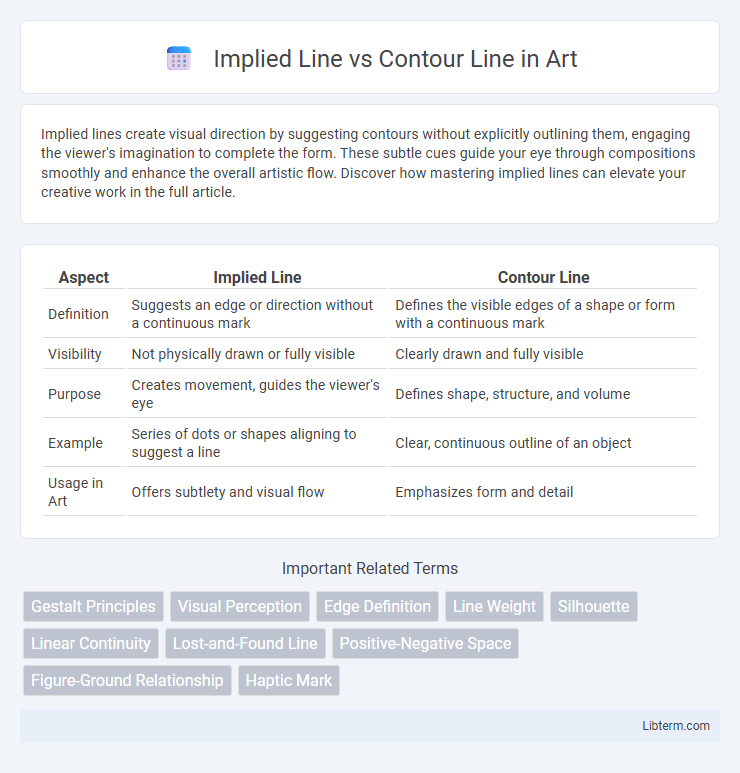Implied lines create visual direction by suggesting contours without explicitly outlining them, engaging the viewer's imagination to complete the form. These subtle cues guide your eye through compositions smoothly and enhance the overall artistic flow. Discover how mastering implied lines can elevate your creative work in the full article.
Table of Comparison
| Aspect | Implied Line | Contour Line |
|---|---|---|
| Definition | Suggests an edge or direction without a continuous mark | Defines the visible edges of a shape or form with a continuous mark |
| Visibility | Not physically drawn or fully visible | Clearly drawn and fully visible |
| Purpose | Creates movement, guides the viewer's eye | Defines shape, structure, and volume |
| Example | Series of dots or shapes aligning to suggest a line | Clear, continuous outline of an object |
| Usage in Art | Offers subtlety and visual flow | Emphasizes form and detail |
Introduction to Implied and Contour Lines
Implied lines guide the viewer's eye by creating a connection between visual elements without an actual drawn line, often formed through alignment, color, or edge contrast. Contour lines define the edges and surface details of an object, emphasizing its shape and volume through continuous, deliberate strokes. Understanding the distinction between implied and contour lines is essential for artists to effectively manipulate visual perception and depth in their compositions.
Defining Implied Line in Art
Implied lines in art create visual pathways that guide the viewer's eye without being explicitly drawn, relying on elements like shapes, colors, and edges to suggest a line's presence. Unlike contour lines, which define the explicit edges of a form, implied lines establish connections between separate points, shapes, or objects, generating movement and flow within the composition. Artists use implied lines to evoke mood, direct focus, and add depth without the need for continuous, solid lines.
What is a Contour Line?
A contour line is a continuous line that defines the edges and shapes of an object, providing clear boundaries and emphasizing its form. It is a key visual element in drawing and design that outlines the subject, making it distinctly recognizable. Unlike implied lines, contour lines are explicitly drawn, creating a direct and solid connection between points.
Key Differences Between Implied and Contour Lines
Implied lines suggest edges or shapes through a series of points or changes in texture, allowing the viewer's eye to connect elements without a continuous mark, while contour lines explicitly define the boundaries of an object with continuous, clear strokes. Contour lines emphasize the actual shape and form by outlining every visible edge, whereas implied lines create direction and movement by hinting at connections within the composition. Understanding these differences enhances artistic techniques in drawing, painting, and design to guide visual perception effectively.
Visual Examples of Implied Lines
Implied lines guide the viewer's eye through a composition using visual elements such as shapes, colors, or textures that suggest a line without it being physically drawn, like the alignment of a row of trees or the direction of a figure's gaze. In contrast, contour lines explicitly define the edges of objects with continuous strokes, creating clear boundaries and shapes. Visual examples of implied lines include the edge of shadows forming an invisible pathway or a series of dots arranged to suggest a flowing curve, enhancing movement and depth in artwork.
Visual Examples of Contour Lines
Visual examples of contour lines include the outlines of objects such as the edges of a leaf, the silhouette of a mountain range, or the borders of a building, which create a clear boundary and define shape and form. Unlike implied lines, which suggest a line through alignment or visual connection of separate elements, contour lines explicitly draw the object's edge, providing a distinct, continuous outline. This makes contour lines crucial in art and design for emphasizing structure and spatial relationships in two-dimensional representations.
Roles of Implied and Contour Lines in Composition
Implied lines guide the viewer's eye through a composition by suggesting movement or connection without continuous markings, enhancing visual flow and narrative depth. Contour lines define the edges and shapes of objects clearly, establishing form and structure within an artwork. Together, they balance clarity and dynamism, creating compositions that are both grounded and engaging.
Techniques for Creating Implied Lines
Techniques for creating implied lines involve strategically placing shapes, edges, or color contrasts to guide the viewer's eye along an invisible path, suggesting movement or connection without a continuous physical line. Artists often use the alignment of individual elements, the repetition of shapes, or the progression of light and shadow to form implied lines that enhance composition and depth. Implied lines differ from contour lines, which explicitly define the edges of forms, by relying on visual cues and viewer perception to create a subtle directional flow.
Techniques for Drawing Contour Lines
Techniques for drawing contour lines include using continuous, unbroken strokes to define the edges and surface details of an object, capturing its three-dimensional form. Artists often employ varying line weights and pressure to emphasize depth and volume, enhancing the illusion of realism. In contrast to implied lines, contour lines rely on deliberate, visible marks that guide the viewer's eye around the figure or shape.
When to Use Implied vs. Contour Lines in Art
Use implied lines in art to guide viewers' eyes subtly through a composition, creating movement and suggesting shapes without explicit boundaries, ideal for evoking emotion or atmosphere. Employ contour lines when emphasizing the precise edges and detailed forms of objects, enhancing clarity and structure, especially in realistic or technical drawings. Balancing implied and contour lines effectively enhances depth, focus, and visual interest in artwork.
Implied Line Infographic

 libterm.com
libterm.com